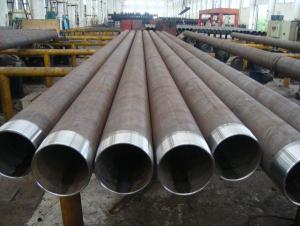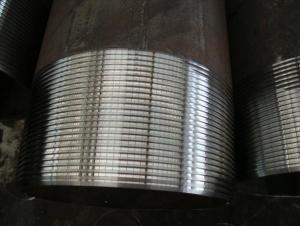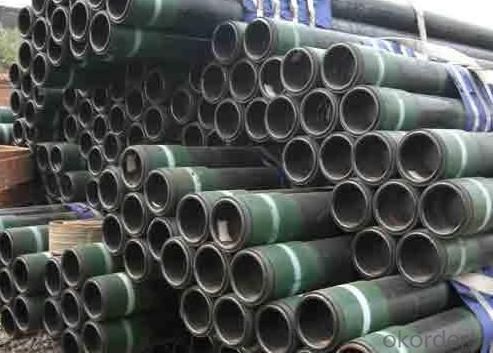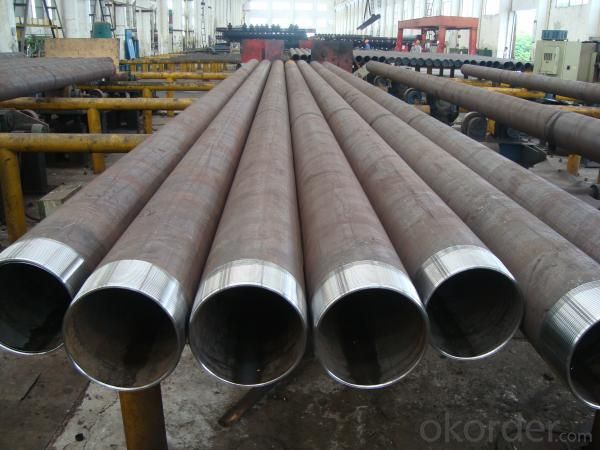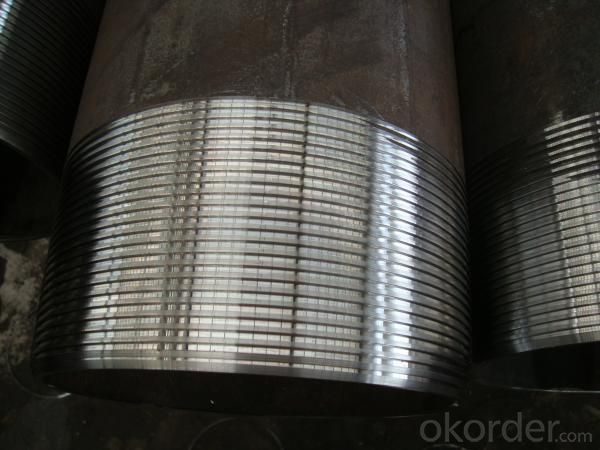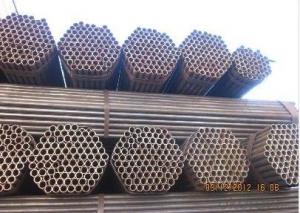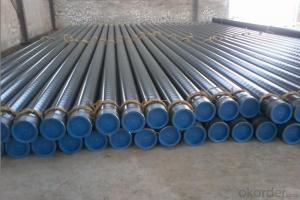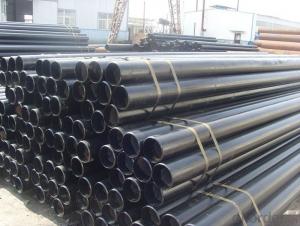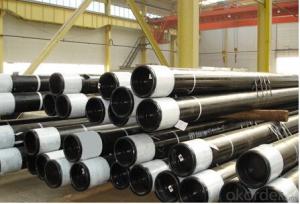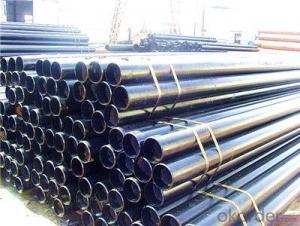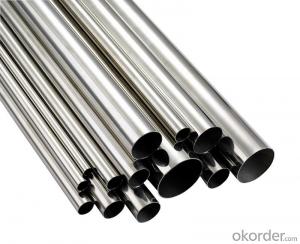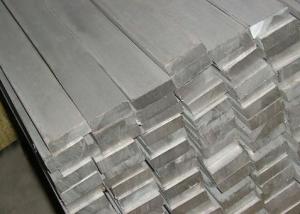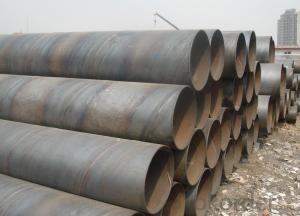Oil Tubing / Petroleum Pipe
- Loading Port:
- Baoshan Port
- Payment Terms:
- TT or LC
- Min Order Qty:
- 50MT m.t.
- Supply Capability:
- 5000 Tons Per Month m.t./month
OKorder Service Pledge
OKorder Financial Service
You Might Also Like
1. Outside Diameter of Oil Tubing / Petroleum Pipe
For upset pipe, the following tolerances apply to the outside diameter of the pipe body immediately behind the upset for a distance of approximately 127 mm (5.0 in) for sizes Label 1: 5-1/2 and smaller, and a distance approximately equal to the outside diameter for sizes larger than Label 1: 5-1/2. Measurements shall be made with callipers or snap gauges.
|
Label 1 |
Tolerances behind meuor L0 |
|
£3-1/2 |
+ 2.38 mm to – 0.79 mm (+ 3/32 in to – 1/32 in) |
|
|
|
|
>3-1/2 to £5 |
+ 2.78 mm to – 0.75% D(+ 7/64 in to – 0.75% D) |
|
|
|
|
>5 to £8-5/8 |
+ 3,18 mm to – 0,75% D(+ 1/8 in to –0.75% D) |
|
|
|
|
>8-5/8 |
+ 3,97 mm to – 0,75% D(+ 5/32 in to – 0.75% D) |
|
|
|
For Label 1: 2-3/8 and larger external-upset tubing the following tolerances shall apply to the outside diameter at distance La(see Figure D.5) from the end of the pipe.
The measurements shall be made with snap gauges or calli pers. Changes in diameter between Laand Lbshall be smooth and gradual. Pipe body OD tolerances do not apply for a distance of Lbfrom the end of the pipe.
|
|
Label 1 |
Tolerances |
|
|
|
|
|
|
³2-3/8 to £3-1/2 |
+ 2,38 mm to – 0,79 mm (+ 3/32 in to – 1/32 in) |
|
|
|
|
|
|
>3-1/2 to £4 |
+ 2,78 mm to – 0,79 mm (+ 7/64 in to – 1/32 in) |
|
|
|
|
|
|
>4 |
+ 2,78 mm to – 0,75% D(+ 7/64 in to – 0.75% D) |
|
|
|
|
|
2. Wall thickness of Oil Tubing / Petroleum Pipe |
| |
|
Tolerance – 12,5% |
| |
|
3. Mass of Oil Tubing / Petroleum Pipe |
| |
|
Amount |
Tolerance | |
|
Single lengths |
+ 6.5% to – 3.5% | |
|
Carload 18 144 kg (40 000 lb) or more |
– 1.75% | |
|
Carload less than 18 144 kg (40 000 lb) |
– 3.5% | |
|
Order items 18 144 kg (40 000 lb) or more |
– 1.75% | |
|
Order items less than 18 144 kg (40 000 lb) |
– 3.5% | |
Details picturers of Oil Tubing / Petroleum Pipe shown as below,
Package:By Strip.Black painting ,plastic caps,marks on pipe body.
We are also a manufacturer,so we can provide the products in conformity with your requirements rapidly.
Our products is accord with the standard of API 5L, API 5CT of American Petroleum Institute,the standard of ASTM A252,ASTM A53 and ASTM A500 of American Society Testing and Materials and standard of EN10217 and EN10219 of the European Union and passed the certification of ISO90012008 International quality management system.
Production line,imported equipment with high technology to low down cost,so we offer low price with good quality.
Our company has rich technical force and advanced production equipment and coordinated advanced test equipment and method.
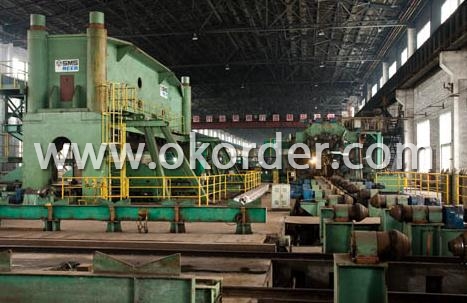
Advanced production line.Ensure good quality.
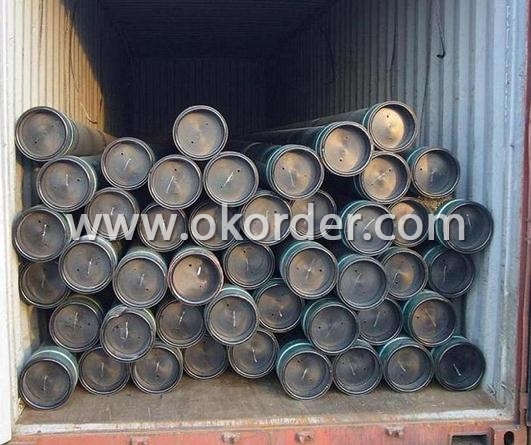
Container loading,professional and experienced service team for clients to ensure no damage.
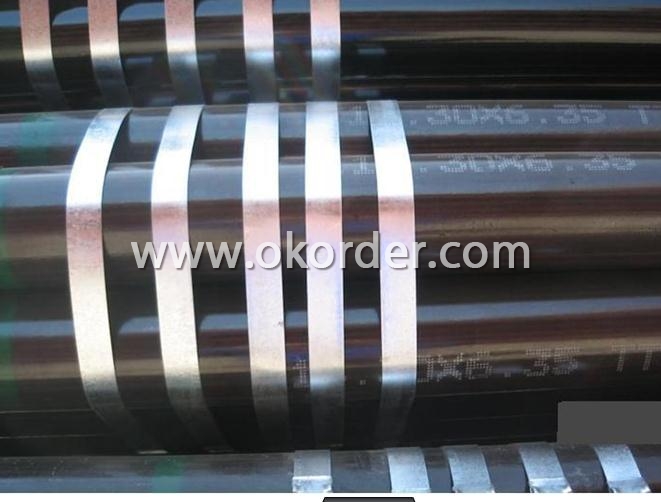
With steel strip to make sure good condition.
Welcome to order from us for Oil Tubing / Petroleum Pipe.
We will be happy to give you a excellent quotation according to your detailed requirements.
- Q: Are steel pipes suitable for underground oil pipelines?
- Steel pipes are indeed appropriate for underground oil pipelines. Steel is frequently employed in oil pipelines because of its considerable strength, durability, and resistance to corrosion. Underground oil pipelines encounter different external influences like soil displacement, humidity, and chemicals, but steel pipes can effectively endure these circumstances. Furthermore, by welding steel pipes, a seamless and uninterrupted pipeline can be formed, minimizing the chances of leaks or ruptures. Furthermore, steel pipes have a long history of successful utilization in the oil sector, offering a dependable and cost-efficient method of transporting oil underground.
- Q: Material of welded steel pipe
- GB/T3092-1993 (galvanized steel pipe for low pressure fluid delivery). Mainly used to transport water, gas, air, oil and heating, hot water or steam, etc. generally lower pressure fluid and other use tube. Its representative material is: Q235 grade a steel.GB/T14291-1992 (mine fluid conveying welded steel pipe). It is mainly used in mine pressure air, drainage and vertical seam gas welding pipe. Its representative material is Q235A, B grade steel.
- Q: How do steel pipes handle water erosion?
- Steel pipes are highly resistant to water erosion due to their inherent strength and durability. The smooth surface of steel pipes minimizes friction and turbulence, reducing the likelihood of erosion. Additionally, steel pipes can be coated with protective layers, such as galvanization or epoxy, that further enhance their resistance to water erosion.
- Q: What are the factors affecting the cost of steel pipes?
- The factors affecting the cost of steel pipes include the price of raw materials such as iron ore and coal, the cost of energy and transportation, market demand and supply dynamics, currency exchange rates, manufacturing and labor costs, and any additional taxes or tariffs imposed on steel imports. Other factors may include technological advancements, regulatory compliance, and the overall economic conditions of producing countries.
- Q: What is the difference between steel pipe and ductile iron pipe?
- Steel pipe and ductile iron pipe are both commonly used in various industries for transporting fluids and gases. However, there are some key differences between the two materials. One of the main differences is their composition. Steel pipe is made primarily of iron and carbon, with other alloying elements added to enhance its strength and corrosion resistance. On the other hand, ductile iron pipe is a form of cast iron that has been treated to improve its ductility and toughness. It contains higher amounts of carbon and silicon, along with small amounts of other elements such as magnesium and copper. Another difference is their strength and durability. Steel pipe is known for its high strength and can withstand higher pressures and stresses compared to ductile iron pipe. It is also more resistant to impact and bending, making it suitable for applications where high strength is required. Ductile iron pipe, although not as strong as steel, still offers good strength and durability, especially in applications where there is a risk of external damage or heavy loads. Corrosion resistance is another factor to consider. Steel pipe is typically more resistant to corrosion due to the addition of alloying elements such as chromium and nickel. This makes it suitable for applications where there is a high risk of corrosion, such as pipelines carrying corrosive fluids. Ductile iron pipe, while also having some corrosion resistance, may require additional protective coatings to enhance its durability in corrosive environments. Installation and maintenance are also different for these two types of pipes. Steel pipe is generally lighter and easier to handle, making it easier to install. It can also be welded, which allows for more flexibility in the construction process. Ductile iron pipe, being a cast iron material, requires more specialized installation techniques, such as using mechanical joints or flanges. It is also more prone to cracking during installation if not handled properly. In terms of cost, steel pipe is generally more expensive than ductile iron pipe. This is due to the higher cost of raw materials and the additional processing required to produce steel pipe. However, it is important to consider the overall lifecycle cost, as steel pipe's higher strength and corrosion resistance may result in lower maintenance and replacement costs in the long run. In summary, while both steel pipe and ductile iron pipe have their own advantages and applications, the choice between the two depends on factors such as strength requirements, corrosion resistance, installation methods, and budget considerations. Careful consideration of these factors will help determine which pipe material is most suitable for a specific application.
- Q: What are the common standards for coating and lining of steel pipes?
- Various organizations and regulatory bodies have outlined the common standards for coating and lining steel pipes to ensure their durability, corrosion resistance, and overall quality. These standards are widely recognized and utilized in different industries. Here are some examples: 1. The American Society for Testing and Materials (ASTM) has developed numerous standards for coating and lining steel pipes. For instance, ASTM A775/A775M addresses epoxy-coated reinforcing steel, ASTM A1064/A1064M focuses on metallic-coated steel wire, and ASTM A1057/A1057M covers fusion-bonded epoxy-coated steel reinforcement. 2. The American Water Works Association (AWWA) has established standards specifically for coating and lining steel pipes used in the water industry. AWWA C210 deals with liquid epoxy coating systems for both the interior and exterior of steel water pipelines, while AWWA C213 focuses on fusion-bonded epoxy coating for these pipelines. 3. The National Association of Corrosion Engineers (NACE) develops standards and recommended practices for corrosion control in steel pipes. NACE SP0169 provides guidelines for selecting and applying coatings for underground or submerged steel pipelines, and NACE SP0198 offers recommendations for external coatings of steel pipelines. 4. The International Organization for Standardization (ISO) has also developed various standards pertaining to coating and lining steel pipes. ISO 21809-1 specifies the requirements for external coatings applied to buried or submerged pipelines, while ISO 21809-2 concentrates on the internal coating and lining of such pipelines. These standards encompass multiple aspects of the coating and lining process, including surface preparation, application methods, minimum coating thickness, adhesion, and quality control. Adhering to these standards ensures that steel pipes receive proper protection against corrosion, abrasion, and other forms of deterioration. Consequently, they enjoy a longer service life and enhanced performance in industries such as oil and gas, water supply, and infrastructure.
- Q: Can steel pipes be used for geothermal applications?
- Yes, steel pipes can be used for geothermal applications. Steel pipes have high strength and durability, which makes them suitable for handling the high temperatures and pressures involved in geothermal systems. Additionally, steel pipes are resistant to corrosion and can withstand the harsh conditions found deep underground, making them a reliable choice for transporting geothermal fluids.
- Q: How are steel pipes used in the construction of nuclear power plants?
- Steel pipes are widely used in the construction of nuclear power plants for various critical applications. They are employed in the primary coolant system, where they carry and circulate the pressurized water or liquid metal coolant that transfers heat from the reactor core to the steam generator. Steel pipes are also utilized in the secondary coolant system, which transports the generated steam to drive the turbine for electricity production. Additionally, steel pipes are used for the construction of various auxiliary systems, such as the emergency cooling system or the ventilation system, ensuring the safe and efficient operation of nuclear power plants.
- Q: How do you calculate the maximum allowable deflection for steel pipes?
- When calculating the maximum allowable deflection for steel pipes, various factors must be taken into account. These factors include the pipe diameter, material properties, support conditions, and desired level of deflection. The maximum allowable deflection is typically determined according to industry standards and codes. One popular method for calculating the maximum allowable deflection is based on the pipe's span-to-diameter ratio, also known as the L/D ratio. The L/D ratio is calculated by dividing the pipe's span (the distance between supports) by its diameter. Numerous industry codes provide guidelines for the maximum allowable deflection based on the L/D ratio. For instance, the American Society of Mechanical Engineers (ASME) B31.1 Power Piping Code suggests that for carbon steel pipes, the maximum allowable deflection should not exceed 3% of the pipe's span when the L/D ratio is 100 or less. However, as the L/D ratio increases, the deflection limit decreases to ensure the pipe's stability and structural integrity. To calculate the maximum allowable deflection using the L/D ratio method, you first need to determine the L/D ratio based on the pipe's span and diameter. Then, you can refer to the applicable code or standard to find the corresponding maximum allowable deflection limit. It's important to note that other factors, such as the pipe material's yield strength, wall thickness, and the type of loading (e.g., dead load, live load), also influence the maximum allowable deflection. Therefore, it is crucial to consult the relevant industry standards, codes, and engineering principles to accurately calculate the maximum allowable deflection for steel pipes.
- Q: What are the factors affecting the pressure rating of steel pipes?
- The factors affecting the pressure rating of steel pipes include the thickness and quality of the steel used, the diameter and length of the pipes, the temperature and fluid being transported, as well as the design and construction of the pipe system.
1. Manufacturer Overview
| Location | Shanghai China |
| Year Established | 1999 |
| Annual Output Value | Above Thirty Million RMB |
| Main Markets | Main land;Middle East; Southeast Asia |
| Company Certifications | ISO 9001:2010;API 5L |
2. Manufacturer Certificates
| a) Certification Name | |
| Range | |
| Reference | |
| Validity Period |
3. Manufacturer Capability
| a) Trade Capacity | |
| Nearest Port | Baoshan |
| Export Percentage | 41% - 50% |
| No.of Employees in Trade Department | 300-500 People |
| Language Spoken: | English; Chinese |
| b) Factory Information | |
| Factory Size: | 30,000 square meters |
| No. of Production Lines | Above 10 |
| Contract Manufacturing | OEM Service Offered; Design Service Offered |
| Product Price Range | Average |
Send your message to us
Oil Tubing / Petroleum Pipe
- Loading Port:
- Baoshan Port
- Payment Terms:
- TT or LC
- Min Order Qty:
- 50MT m.t.
- Supply Capability:
- 5000 Tons Per Month m.t./month
OKorder Service Pledge
OKorder Financial Service
Similar products
Hot products
Hot Searches
Related keywords
